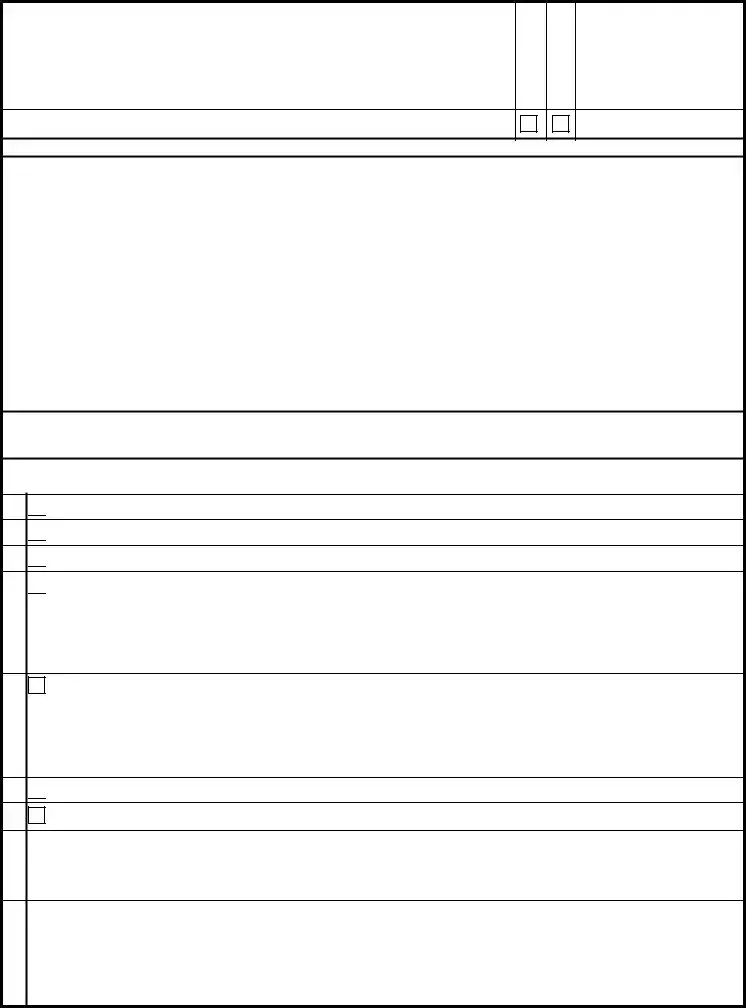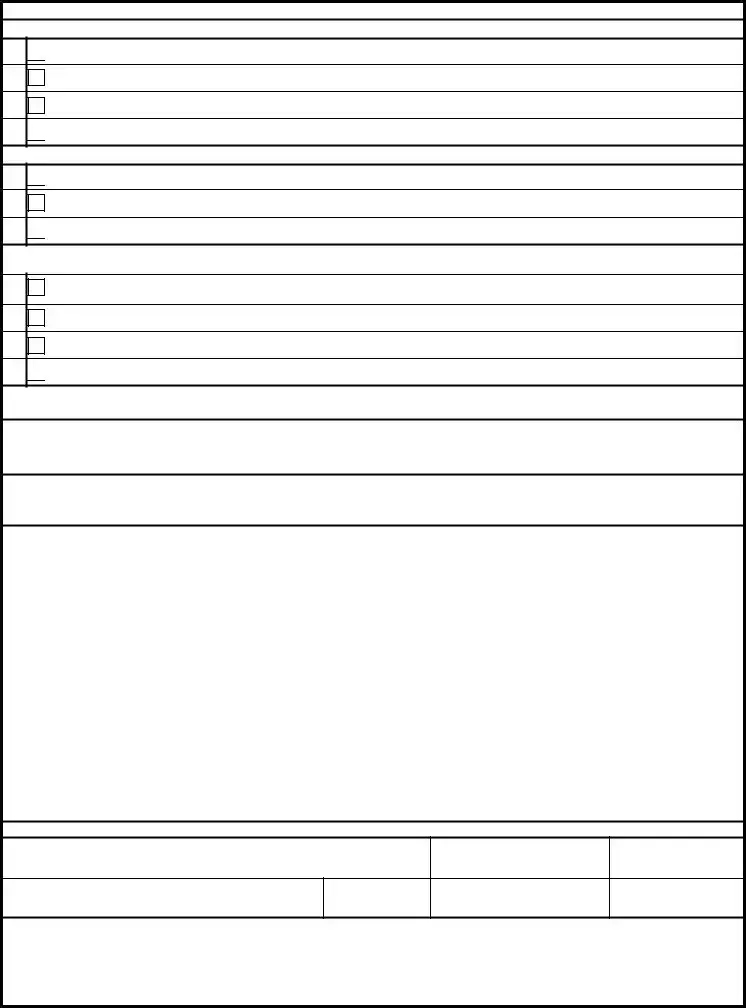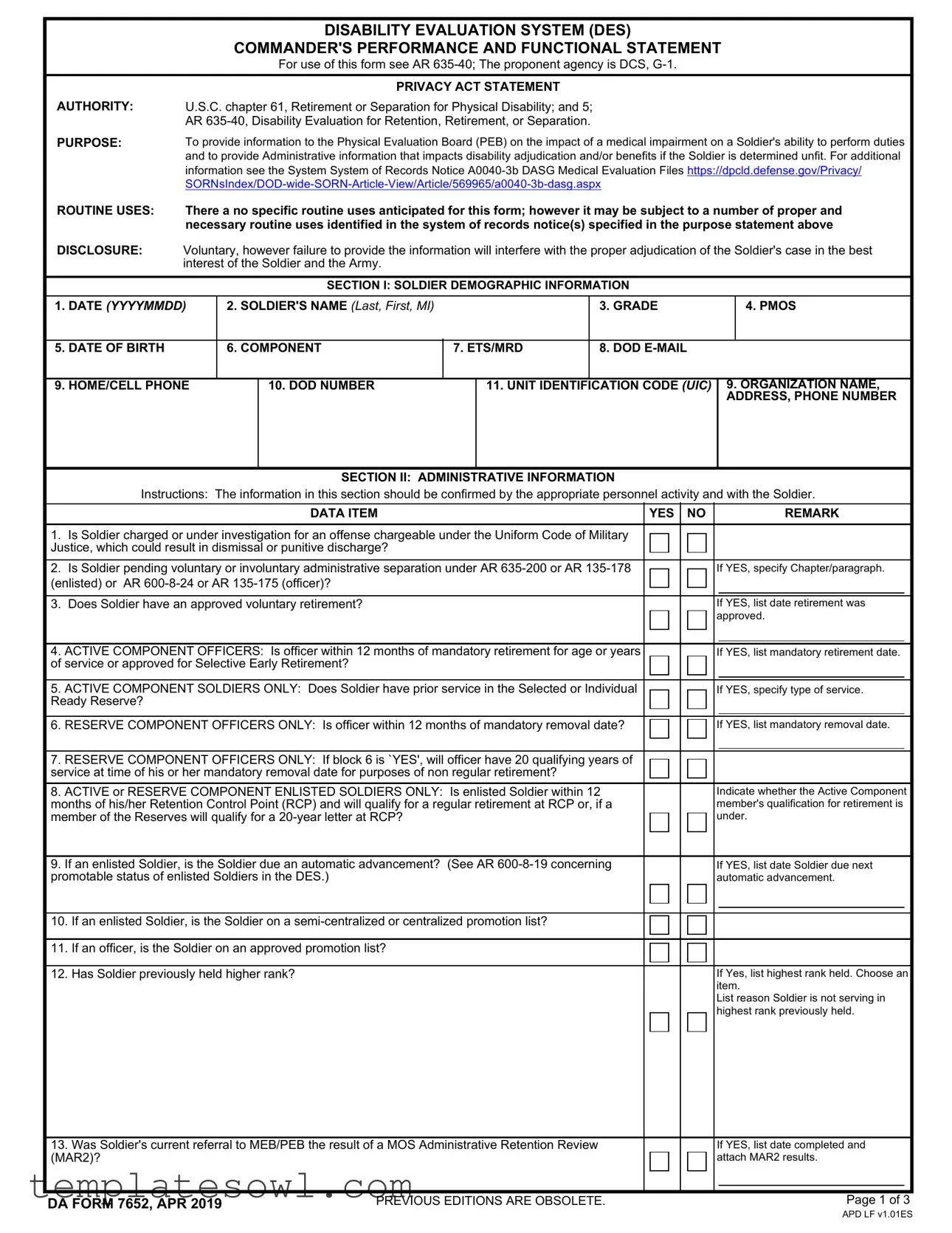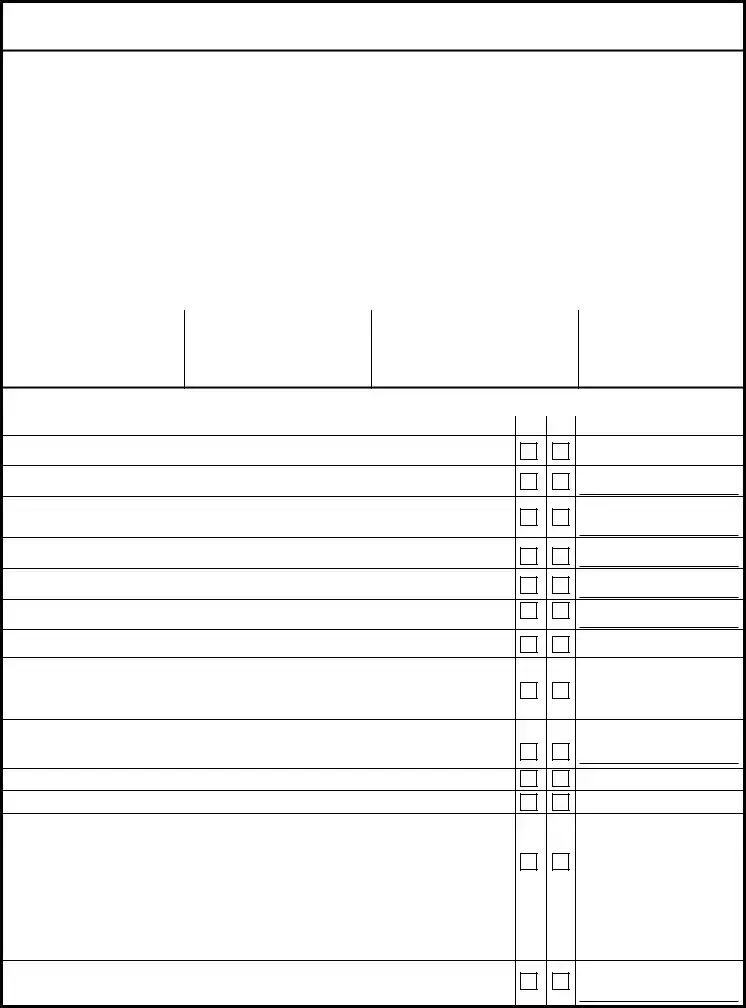APD LF v1.01ES
If YES, specify Chapter/paragraph.
If YES, list date retirement was approved.
If YES, list mandatory retirement date.
If YES, specify type of service.
If YES, list mandatory removal date.
Indicate whether the Active Component member's qualification for retirement is under.
If YES, list date Soldier due next automatic advancement.
If Yes, list highest rank held. Choose an item.
List reason Soldier is not serving in highest rank previously held.
If YES, list date completed and attach MAR2 results.
DISABILITY EVALUATION SYSTEM (DES)
COMMANDER'S PERFORMANCE AND FUNCTIONAL STATEMENT
For use of this form see AR 635-40; The proponent agency is DCS, G-1.
PRIVACY ACT STATEMENT
AUTHORITY: U.S.C. chapter 61, Retirement or Separation for Physical Disability; and 5;
AR 635-40, Disability Evaluation for Retention, Retirement, or Separation.
PURPOSE: To provide information to the Physical Evaluation Board (PEB) on the impact of a medical impairment on a Soldier's ability to perform duties and to provide Administrative information that impacts disability adjudication and/or benefits if the Soldier is determined unfit. For additional information see the System System of Records Notice A0040-3b DASG Medical Evaluation Files https://dpcld.defense.gov/Privacy/ SORNsIndex/DOD-wide-SORN-Article-View/Article/569965/a0040-3b-dasg.aspx
ROUTINE USES: |
There a no specific routine uses anticipated for this form; however it may be subject to a number of proper and |
|
necessary routine uses identified in the system of records notice(s) specified in the purpose statement above |
DISCLOSURE: |
Voluntary, however failure to provide the information will interfere with the proper adjudication of the Soldier's case in the best |
|
interest of the Soldier and the Army. |
|
|
|
|
|
|
|
SECTION I: SOLDIER DEMOGRAPHIC INFORMATION |
|
|
|
1. DATE (YYYYMMDD) |
2. SOLDIER'S NAME (Last, First, MI) |
|
3. GRADE |
|
4. PMOS |
|
|
|
|
|
|
|
|
5. DATE OF BIRTH |
|
6. COMPONENT |
7. ETS/MRD |
8. DOD E-MAIL |
|
|
|
|
|
|
|
|
|
|
9. HOME/CELL PHONE |
10. DOD NUMBER |
11. UNIT IDENTIFICATION CODE (UIC) |
9. ORGANIZATION NAME, |
|
|
|
|
|
ADDRESS, PHONE NUMBER |
SECTION II: ADMINISTRATIVE INFORMATION
Instructions: The information in this section should be confirmed by the appropriate personnel activity and with the Soldier.
1.Is Soldier charged or under investigation for an offense chargeable under the Uniform Code of Military Justice, which could result in dismissal or punitive discharge?
2. Is Soldier pending voluntary or involuntary administrative separation under AR 635-200 or AR 135-178 (enlisted) or AR 600-8-24 or AR 135-175 (officer)?
3. Does Soldier have an approved voluntary retirement?
4. ACTIVE COMPONENT OFFICERS: Is officer within 12 months of mandatory retirement for age or years of service or approved for Selective Early Retirement?
5. ACTIVE COMPONENT SOLDIERS ONLY: Does Soldier have prior service in the Selected or Individual Ready Reserve?
6. RESERVE COMPONENT OFFICERS ONLY: Is officer within 12 months of mandatory removal date?
7.RESERVE COMPONENT OFFICERS ONLY: If block 6 is `YES', will officer have 20 qualifying years of service at time of his or her mandatory removal date for purposes of non regular retirement?
8. ACTIVE or RESERVE COMPONENT ENLISTED SOLDIERS ONLY: Is enlisted Soldier within 12 months of his/her Retention Control Point (RCP) and will qualify for a regular retirement at RCP or, if a member of the Reserves will qualify for a 20-year letter at RCP?
9. If an enlisted Soldier, is the Soldier due an automatic advancement? (See AR 600-8-19 concerning promotable status of enlisted Soldiers in the DES.)
10. If an enlisted Soldier, is the Soldier on a semi-centralized or centralized promotion list?
11. If an officer, is the Soldier on an approved promotion list?
12. Has Soldier previously held higher rank?
13. Was Soldier's current referral to MEB/PEB the result of a MOS Administrative Retention Review (MAR2)?
DA FORM 7652, APR 2019 |
PREVIOUS EDITIONS ARE OBSOLETE. |
Page 1 of 3 |

14. Is the Soldier flagged IAW any provision of AR 600-8-2? |
|
|
|
|
If YES, specify the reason and date of |
|
|
|
|
the flag. |
|
|
|
|
|
|
|
|
|
|
|
|
|
|
|
|
|
|
|
|
|
|
|
|
|
|
15. Is the Soldier assigned a Warrior Transition Unit or other medical type hold type unit? |
|
|
|
If YES, attach the commander's |
|
|
|
|
memorandum used to refer the Soldier |
|
|
|
|
to this unit with this form. |
|
|
|
16.If a drilling USAR or ARNG Soldier (and not on active duty), did the Soldier accept the Career Status Bonus?
SECTION III: COMMANDER'S PERFORMANCE INFORMATION
This form is a critical document in determining the effects the Soldier's medical condition(s) (both physical and/or mental) have on their military performance. It is essential to provide accurate information, whether it is from the current or former commanders, NCO leadership, immediate supervisor, or peers. The Commander's Performance and Functional Statement must be complete and provide an accurate picture of the Soldier's actual functional limitations and duty performance. The Soldier's commander and leadership team are in a unique position to provide this information. Even if this statement is difficult to obtain, (e.g., the Soldier or Commander is new to the unit, the Soldier's condition prevents drill attendance, etc.) the statement must be completed to the maximum extent possible.
You are entering information into a performance-based system. Describe how the Soldier's medical condition(s) (both physical and/or mental) affects his or her ability to perform basic Soldier skills; the skills and duties of the primary military occupational specialty (PMOS); and how the Soldier's condition impacts or affects unit mission readiness. (Note: Performance information is of greater significance for Soldiers with chronic conditions. Severe, acute physical conditions generally need little performance discussion because the PEB members easily understand the limitations posed by such impairments.) If a condition prevents the Soldier from executing a task(s) that is required by his/her MOS, please specify what MOS task(s) cannot be executed in Section III C.
In all cases of Medical Corps officers with a clinical specialty area of concentration and assigned to a clinical position, Sections III and V will be completed by the officer's first line clinical supervisor. In all cases of officers of the Judge Advocate General Corps (JAG), Sections III and V will be completed by the officer's Staff Judge Advocate, Command Judge Advocate, or agency/section legal supervisor.
All sections must be completed
SECTION III A
Choose the answer that most accurately describes the impact of the Soldier's medical condition in completion of physical tasks/duty completion; decision making; and work relationships.
1.Physical Task/duty completion: Based on your knowledge and/or understanding of this Soldier's performance of physical duties both within and outside their MOS, this Soldier:
A
 Performs tasks and/or duties to standards.
Performs tasks and/or duties to standards.
B
 Has difficulties completing tasks and/or duties to standards.
Has difficulties completing tasks and/or duties to standards.
C
 Is unable to complete task and or duties to standards.
Is unable to complete task and or duties to standards.
D
 Do you believe the member's condition(s) will prevent him/her from serving in their primary MOS/AOC in future assignments? If so, how?
Do you believe the member's condition(s) will prevent him/her from serving in their primary MOS/AOC in future assignments? If so, how?
EHas the member's duty schedule been modified due to his/her medical condition(s) (i.e., limited duty, half days, no shift work, etc.)? If so, how and for how long?
F
 Other than medical appointments, approximately how many days of work has the member missed over the past 90-360 days due to this condition?
Other than medical appointments, approximately how many days of work has the member missed over the past 90-360 days due to this condition?
GIs the commander/first line supervisor aware of the Soldier's medical condition? If YES, what job tasks does the medical condition prevent the Soldier from adequately performing? If NO, please explain.
If the medical condition is due to an injury, was the injury due to a vehicle accident or other incident requiring a line of duty? If so, was a line of duty completed (attach the completed LOD or initiate one if not completed)?
DA FORM 7652, APR 2019 |
Page 2 of 3 |

SECTION III A (Continued)
2. Decision Making: Based on your knowledge and/or understanding of the Soldier, he/she:
A
 Makes reasonable decisions, including complex or unfamiliar ones.
Makes reasonable decisions, including complex or unfamiliar ones.
BMakes reasonable decisions; occasionally makes (or avoids making) unreasonable complex or unfamiliar decisions; makes occasional decision making mistakes.
CMakes simple decisions but usually not complex or unfamiliar decisions; does not make frequent decision-making mistakes when making simple decisions.
D
 Do you believe the member's condition(s) will prevent him/her from serving in their primary MOS/AOC in future assignments? If so, how?
Do you believe the member's condition(s) will prevent him/her from serving in their primary MOS/AOC in future assignments? If so, how?
3.Work Relationships: Based on your knowledge and/or understanding of this Soldier's interactions with supervisors and co-workers, he/she:
A
 Has effective work relationships with both supervisors and co-workers.
Has effective work relationships with both supervisors and co-workers.
BHas difficulty with work relationships, and may be disurptive or cause problems with tasks performance and/or completion.
C
 Is unable to maintain effective work relationships.
Is unable to maintain effective work relationships.
4.Performance: Considering Section III A, questions 1-3 above and based on your knowledge and/or understanding of this Soldier's work performance, choose the most accurate description of the Soldier's medical condition(s) affect(s) on their performance:
ASoldier performs well and the medical condition(s) do not appear to have any negative affects on the performance of his/her duties; medical conditions do not affect the unit's mission.
BSoldier's performance is adequate but it appears that the medical condition(s) may have negative affects on the performance of his/her duties; medical conditions do not affect the unit's mission.
CSoldier's performance is inadequate and it appears that the medical condition(s) have negative affects on the performance of his/her duties; medical conditions negatively affect the unit's mission
D
 Soldier is unable to perform any significant military tasks or duties because of their medical condition(s); unable to conttibute to the unit's mission.
Soldier is unable to perform any significant military tasks or duties because of their medical condition(s); unable to conttibute to the unit's mission.
SECTION III B
Choose the answer that most accurately describes the Soldiers ability to deploy. When "No" is chosen, the commander will elaborate in Section III C.
Yes |
|
No |
|
Can the service member be assigned against a deployable billet? |
|
|
|
|
|
Yes |
|
No |
|
Do you believe the service member could perform his/her duties in an OCONUS deployed environment without restrictions, limitations, |
|
|
|
|
or work-arounds? |
|
|
|
|
SECTION III C
After reviewing Sections II and III A, further clarify an item and/or the selections you have made above and add any additional comments. Please include examples of the Soldier's general and/or MOS/AOC specific task limitation(s) due to their medical condition(s) (both physical and/or mental).
SECTION IV: BATTALION COMMANDER'S CONTACT INFORMATION
1.NAME (Last, First, MI)
4.DOD E-MAIL
SECTION V: COMMANDER'S VALIDATION AND SIGNATURE
|
1. NAME (Last, First, MI) |
|
2. SIGNATURE |
3. DATE |
|
|
|
|
|
|
|
|
4. DOD E-MAIL |
5. PHONE |
6. COMPONENT |
7. GRADE |
DA FORM 7652, APR 2019 |
|
|
Page 3 of 3 |
|
|




 Performs tasks and/or duties to standards.
Performs tasks and/or duties to standards.
 Has difficulties completing tasks and/or duties to standards.
Has difficulties completing tasks and/or duties to standards.
 Is unable to complete task and or duties to standards.
Is unable to complete task and or duties to standards.
 Do you believe the member's condition(s) will prevent him/her from serving in their primary MOS/AOC in future assignments? If so, how?
Do you believe the member's condition(s) will prevent him/her from serving in their primary MOS/AOC in future assignments? If so, how?
 Other than medical appointments, approximately how many days of work has the member missed over the past
Other than medical appointments, approximately how many days of work has the member missed over the past 

 Makes reasonable decisions, including complex or unfamiliar ones.
Makes reasonable decisions, including complex or unfamiliar ones.
 Do you believe the member's condition(s) will prevent him/her from serving in their primary MOS/AOC in future assignments? If so, how?
Do you believe the member's condition(s) will prevent him/her from serving in their primary MOS/AOC in future assignments? If so, how?
 Has effective work relationships with both supervisors and
Has effective work relationships with both supervisors and 
 Is unable to maintain effective work relationships.
Is unable to maintain effective work relationships.
 Soldier is unable to perform any significant military tasks or duties because of their medical condition(s); unable to conttibute to the unit's mission.
Soldier is unable to perform any significant military tasks or duties because of their medical condition(s); unable to conttibute to the unit's mission.